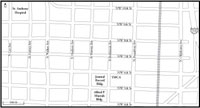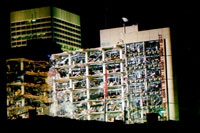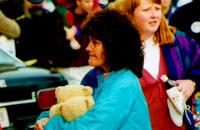An Image from Oklahoma City
David Allen
Journal of American History, 94 (June 2007) 172–8
For the past thirty-one years, I have worked as a free-lance sports and commercial photographer based in Oklahoma City, Oklahoma. Growing up in Bartlesville, Oklahoma, I learned about the world of photography from my father, who traveled everywhere for the Phillips Petroleum Company and brought back pictures that he had taken with his simple camera. While serving in the U.S. Navy, I bought my first camera, a Pentax Spotmatic, and I was hooked on the field. On April 19, 1995, my focus changed at once and permanently—from taking sports shots to covering events related to the bombing of the Alfred P. Murrah Building and its aftermath. I must have learned on the fly to take pictures in a photojournalistic style. One of the images that I took early on involved a rescue worker, Anthony “Skip” Fernandez III from Miami, Florida, and his golden retriever, Aspen. To explain how that picture came to be taken, I feel that it is best to go back to April 19, 1995, and write a little about that day and the week that followed.

View Larger Image
On April 19, 1995, at 9:02 a.m., when a bomb inside a Ryder rental truck exploded, life as I knew it changed forever. That morning, I was at work at a retail camera store as usual. Since I had just arrived, I was chatting with a couple of co-workers at our downstairs counter when our building, located about two miles northwest of the Murrah Building, started shaking from the shock wave of the explosion. Both of the doors started shaking, and the motion did not let up for what seemed like five to ten seconds. None of our windows blew in, and later I thought to myself that we were lucky.
Photographers in Oklahoma City and others from throughout the United States who descended on our city began to show the world what had happened. On April 19, the only pictures I took were a series of photos of the building around 1:30 p.m. I wanted to see what the building looked like after the explosion. On that particular day, having nothing previously scheduled and no idea what the day would bring, I had left my equipment at home. As a result, during my lunch hour I had to go home and get the photo equipment I needed. In retrospect, there have been times when I wished I had grabbed a camera and film from work and gone downtown right away. (Later I spoke with people who had been in that area; all they could talk about was the carnage they had seen.) But I did not go downtown that morning, and I now have no regrets about that.
I had an idea for a good vantage point; I positioned myself on the southeast side of a six-story parking garage across the street directly south of St. Anthony Hospital. Using a 300 mm telephoto lens, I was able to make ten good photographs of the Murrah Building, from an angle that, I felt, not too many others had used. When I returned to work after taking the pictures, I found my wife, Debbie, waiting to borrow my car so that she could get home. Her car was parked in a parking garage on Sixth Street just north of the Journal Record Building, located just north of the Murrah Building. The Federal Bureau of Investigation (fbi) had seized that very parking garage as part of a federal crime scene. When the Ryder truck exploded in front of the Murrah Building, debris went north over the Journal Record Building, some landing on its roof, some in the nearby parking garage that my wife used.

View Larger Image

View Larger Image
On Friday, April 21, I received a call at work from Gamma Liaison (now Getty Images), a New York City–based print distribution company. The company had contacted me about five years before about another tragedy that happened in Oklahoma City. Tom Jones, the director of the Aerospace America air show, had gone up in a Russian stunt plane and, after his second series of stunts, crashed to the ground. I had photographed his performance, never expecting him to crash. Later, the Daily Oklahoman used five of my images, as did the Associated Press.1 Gamma Liaison contacted me about providing them images of the bombing. We reached an agreement, and Gamma sent me credentials by fax that would allow me into the media area as a photographer doing free-lance work for the company.
After work I went downtown and looked around between Fourth and Sixth streets and a couple of blocks west of the Murrah Building. Returning on Fifth Street, I viewed the block just west of the Murrah Building. My first strong image of the area was of how debris-ridden it looked. I saw police cars, trash containers, stockpiled equipment, and firemen taking a short break after, I assume, doing recovery work inside the building. Later that night, with the building bathed in floodlights, I found a spot to take a night pho tograph. To help me accomplish that task, I used a junction box attached to a light pole. I did a series of pictures using a medium 80–200 Nikon zoom lens. The damaged building looked entirely different photographed at night, and, even though it has been more than twelve years since I took those images, my memories of that particular night are still vivid. During the day the building was well lit and stark. Late in the day, approaching dusk, the building appeared more golden due to the setting sun. After dark, though it was bathed in light from floodlights, the building took on a black-and-white appearance. Black from the night surrounded the building, and white from the floodlights that shrouded the building made night seem like day.
Saturday morning, April 22, I went to the media area early. It was located in a parking lot on the southwest corner of Eighth Street and Harvey Avenue, the north-south street just west of the Murrah Building. This designated area quickly filled up with news trucks, cables, and tents. Yellow tape separated the media on the north side and the media liaisons on the south side, with the Murrah Building behind them. Still photographers, I felt, were added to this mix just as an afterthought.
That morning, I arrived a few minutes before the first news briefing. Assistant Fire Chief Jon Hansen was the public information officer, or spokesperson, for the Oklahoma City Fire Department. He had been doing many of the news briefings at various times during the day. The reporters most often asked him, “What is the newest update on the numbers of bodies found in the search inside the rubble of the Murrah Building?” The shorter version was “What’s the count?” Since the media area was two and a half blocks away from the Murrah Building, and since the media had virtually no access to it, the reporters did not have other sources who could answer that question. That morning’s briefing was no different for Jon Hansen. Jon and I had been friends for almost twenty years. I saw the strain on his face from his role as spokesperson to the world. But that morning, after reporters asked about the body count twice, he replied “a one, and a two, and a three, and a four,” as if counting off a beat in music. I feel that was most likely a way for Jon to release a little tension, and everyone around him chuckled in agreement. I thought to myself, “Jon is a very caring individual about what he does. It is good for me to see him smile for just a moment.”
The next day was Sunday, April 23, and I knew it was going to be a very busy day for me photographically. Along with the normal briefings and goings-on around the media area, there was going to be a memorial service at the Oklahoma State Fair Arena, about four miles west of downtown. The first lady of Oklahoma, Cathy Keating, and her staff had quickly arranged this service to remember the victims who died in the bombing of the Murrah Building. President Bill Clinton and the Reverend Billy Graham attended. The first lady of Illinois, Brenda Edgar, sent two thousand PJ Huggabee teddy bears to the service, and they were given out to anyone who had lost a family member. At the state fair arena, two entryways were set up. Entry for the general public was through the main front entrance, and seats were on a first-come-first-served basis. As a free-lance photographer and one not employed by a major agency, I was assigned to a seating area quite distant from the stage. Luckily, I had brought a long lens with me to deal with this problem; I was happy just to be inside attending the service. I arrived early and walked around the arena capturing on film sights such as the Oklahoma City Philharmonic and vocalist Susan Powell, Miss America in 1981 and from Oklahoma, warming up before the start of the service.

View Larger Image
As it got closer to the start of the service, all were informed that they needed to go back to their assigned seats. The memorial service was moving. It was filled with wonderful music, followed by speeches from Gov. Frank Keating and Cathy Keating. Then President Clinton and the Reverend Graham said a few words. Lastly, Susan Powell gave a very moving rendition of the hymn “On Eagles’ Wings.” I do not think that there was a dry eye in the place when the service ended. When I was leaving the arena, I spotted and photographed a woman whom I did not know carrying two of the PJ Huggabee teddy bears. Seeing the aftermath of her loss affected me long after I had departed the state fairgrounds. Later, I tried to find out who she was, but I still do not know her name (See figure 4).
Other than as the start of the second week of the recovery effort, Wednesday, April 26, did not have any significant meaning for me. That would change. I had planned on going to the media area before work. Since my wife’s car had finally been recovered, I was able to leave my house earlier than normal, to make the first news briefings. I decided that I was going to stay around the media area until 8:45 a.m., when I had to leave to get to work on time. Around 8:00 a.m., I looked up and saw two rescue workers with their golden retrievers coming up the street toward the media area. No one was then interviewing the men, so I struck up a conversation with them. I found out they were with Florida Task Force–1, an urban search and rescue team based in Miami. One was Skip Fernandez, and the other man introduced himself as Lt. Joe Beale. He said that they had just finished a twelve-hour shift inside the Murrah Building looking for survivors. During the debriefing following their shift, they were told to go up to the media area to answer questions about their jobs. Shortly thereafter, the question-and-answer session started. First, Skip spoke with the reporters for approximately five to ten minutes. Then the reporters turned to Joe Beale and started their questions for him.
My attention turned to Skip as he and his dog, Aspen, moved to an area about fifteen feet away. Skip sat down next to a curb with Aspen at his side, and I thought to myself, “This is potentially a real strong image shaping up!” I headed in their direction. Getting a little closer, I noticed that Skip had fallen asleep holding onto Aspen. I grabbed my camera and began taking pictures. Aspen had been looking off to her right and then turned my way, permitting me to take a few more pictures from a different angle. Skip started stirring a little, so I stopped photographing this special scene. All in all, I had only taken about eight images. However, I knew that I had captured something exceptional. This moment was something photographers rarely experience, but when it happens, they usually know it is something profound. Checking my watch, I discovered it was time for me to leave. I headed back to where I had parked my car. During the rescue effort, I never again saw those two tired rescue workers or their golden retrievers.2
For me, this scene sparked strong emotions. Here was Skip, who, after working a twelve-hour shift, had succumbed to his tiredness and fallen asleep holding onto Aspen. Then there was Aspen, just as tired as Skip, showing her emotions on her face. Each one helped make the scene strong. People who have seen the shot tell me that it exemplifies the effort that went into trying to find survivors trapped in the Murrah Building. By the time I made this image, it had been determined that there were no more survivors, but that still did not stop Skip and Aspen from spending twelve hours looking. My image, I believe, is one of the only ones showing both Skip’s exhaustion and Aspen’s tiredness and compassion. Dogs are considered man’s best friend, and Aspen was Skip’s workmate and his best friend. She worked right alongside him for so many grueling hours. I am thankful for having been in the right place at the right time and having been able to use my skills as a photographer to create this heartwarming image (See figure 5).

View Larger Image
Since 1995 I have tried to cover events hosted by the Oklahoma City National Memorial and Museum. April 19 anniversaries are especially important for me, as I get to see friends that I have met over the years and to make new friends among the folks who experienced the tragedy on September 11, 2001. The commemorative events at the Oklahoma City National Memorial bring people from all around the United States back to Oklahoma City to remember the loved ones they lost on that tragic April morning. A lot of them have become my friends, and through the years I have tried to be there for support. Being there for those people is very important to me. I have also been fortunate to attend the first and third 9/11 anniversary services, and I will never forget those important events. Some anniversaries, such as the tenth anniversary of the Oklahoma City bombing, were especially poignant, and I was able to attend most of the special events. New York City and Oklahoma City have become a lot closer, and this “shared experience” is something I pray never happens again.3
More than twelve years have passed since this tragedy happened, and my photographs have now become a part of Oklahoma history. I have found that people are startled when I tell them I took this particular image. I am surprised when they tell me that they have seen the image somewhere, either in a publication dealing with the bombing or during a visit to the Oklahoma City National Memorial and Museum. I hear more comments about my Skip and Aspen photo than about almost any other photograph that I have taken. People mention that this image affects them deeply, more than I ever thought it would when I photographed it twelve years ago. Never would I have dreamed that I would create something so powerful and that the subject would be a rescue worker from Florida and his golden retriever. So as I continue to talk to visitors to the memorial, I am hopeful that it helps make their one visit to Oklahoma City a better experience. But for now, I keep on doing what I love—making photographs.
David Allen has been a free-lance sports and commercial photographer in Oklahoma City, Oklahoma, for thirty-one years. His photographs have appeared in numerous books about the 1995 Oklahoma City bombing and related topics. His work has been exhibited in one-man and group shows; ten of his images were selected for permanent exhibition in the Oklahoma City National Memorial Museum.
Readers may contact Allen at ddallen76 [at] aol [dot] com.
1James Johnson, “Aerobatic Champ Killed in Air Show Plunge,” Daily Oklahoman, June 18, 1990, pp. 1, 3. The photographs went out over the Associated Press wire on June 19, 1990.
2Two other photographers (one from the Associated Press and one from the Dallas Morning News) followed me and took similar photographs. A noncredited photograph of Skip and Aspen appeared in John Perry, “Days of Terror, Days of Grief,” Daily Oklahoman, April 30, 1995, p. 19. Many of the photographs I took in the aftermath of the bombing, including the one discussed in this essay, appear in David Cohen, ed., Requiem for the Heartland: The Oklahoma City Bombing (San Francisco, 1995); and Edward T. Linenthal, The Unfinished Bombing: Oklahoma City in American Memory (New York, 2001).
3Oklahoma City National Memorial and Museum, http://www.oklahomacitynationalmemorial.org/.